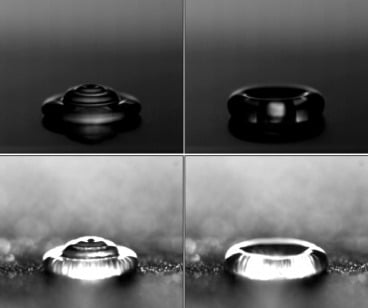Superhydrophobic surfaces resist wetting from water, but it turns out they can also trigger interesting behaviors in the tiny droplets condensing on the surface. High-speed video reveals that when two condensate droplets coalesce, the energy released by surface tension causes the new droplet to jump off the surface. The phenomenon is the same as one observed in some types of mushroom–when a condensate droplet touches a wetted spore, the spore is ejected from the mushroom. (Video credit: J. Boreyko)
Tag: superhydrophobic

Playing Pac-Man with Water Droplets
The vibrations of a plate in the horizontal and vertical directions can be used to control the motion of a drop placed on the surface. Here a droplet of water on a superhydrophobic surface is controlled by joystick a la Pacman. For more, see papers here and here.

To Splash or Not to Splash?
Hydrophobic surfaces tend to repel water while hydrophilic ones attract it. This video explores the effects that hydrophobic and hydrophilic surface coatings can have on spheres when dropped in water. There are noticeable differences in splash formation and wake shape. For more, see this research paper.

Droplet Impact on Superhydrophobic Surfaces
High-speed video of water droplets impacting on superhydrophobic surfaces demonstrates the impressive elasticity and surface tension of the droplets. Impacts vibrate and reflect through the droplet, but only a drop from the largest height actually causes breakup.
Frost on Superhydrophobic Surfaces
Frost formation and ice adhesion on superhydrophobic surfaces
For anyone with further interest in the ice formation on superhydrophobic surfaces story we posted recently, the published paper is currently offered by AIP for free. #

Frosting on Superhydrophobic Surfaces
Icing on airplane wings can be disastrous for lift and control, and thus how ice initially forms on a wing is an active area of research. New work shows that superhydrophobic (water-fearing) surfaces may actually promote ice buildup. Superhydrophobic surfaces are prone to frosting–collecting ice that forms directly from a vaporous state–and that fine layer of frost is conducive to further ice buildup from a liquid state. The photo above shows a water droplet striking a dry superhydrophobic surface (top) and a frosted superhydrophobic surface (bottom). (via Gizmodo) #

